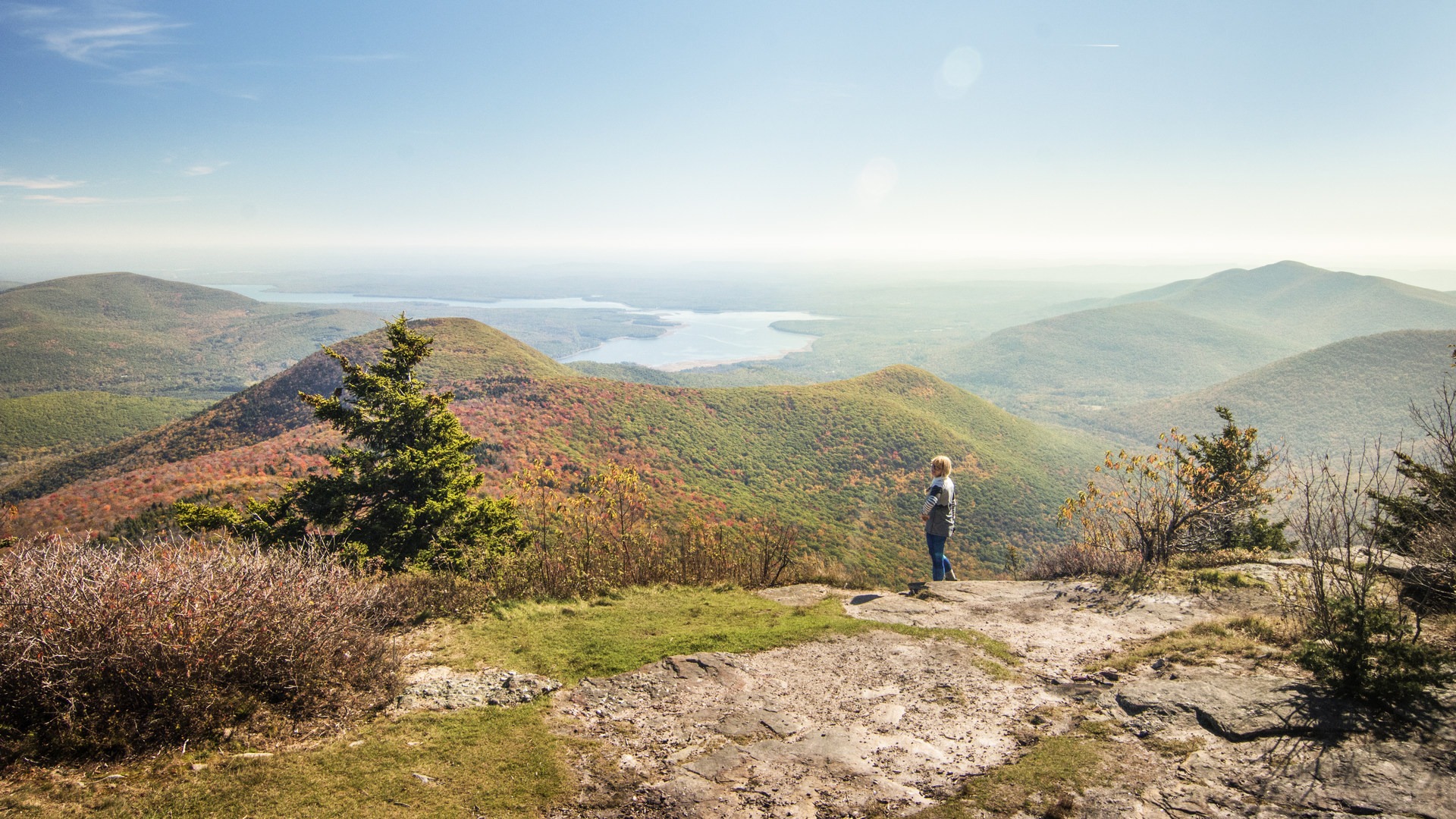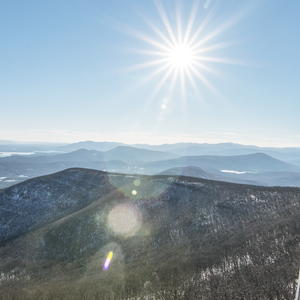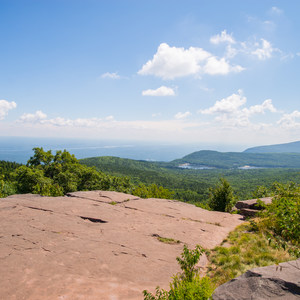As you step out into the brisk morning air, you feel your feet crunch down on some fallen leaves. You look up to see a vibrant array of yellows and reds umbrella over you in the trees. Birds chirp and scatter throughout the brush, gathering as much as they can before the long winter months. You recollect a distant memory of hot summer days and cool swimming holes. Welcome to autumn in New York.
The fall season is an especially exciting time in New York. Whether you decide to hike, bike, or zip line, there are plenty of diverse and incredible activities ready to enchant and entertain you! The number of amazing opportunities for outdoor adventures is almost overwhelming, so we’ve put together a list of our favorite treks to help you make the most of the changing seasons.
The trees in the Catskills begin to transition around the beginning of October and generally peak by the third and fourth weeks of the month. After that, a gradual decline ensues as the locust and maple leaves fall to the ground. Hanging on until late November, the golden brown oak leaves might not come down until the first snow. Finally, the beech trees might let their dried white remains go, but sometimes not until the middle of winter. Throughout this transition, only the firs will maintain their green color, which becomes slightly darker with the colder weather. This splendid transition of colors throughout these mountains creates a wonderful morphing beauty that quickly overtakes the entire region. The change begins at the higher altitudes and makes a descent into the valleys below. “I Love NY” publishes a weekly New York Fall Foliage Report to help you track the peaking colors throughout the state.
Throughout these parts, there are over 50 miles of scenic byways. From the historic Rip Van Winkle route on NY-28A to the narrow pass of NY-214, you’ll have just as much fun riding along as you do on foot. There are also a number of 19th century covered bridges you can find embellishing the scene! “Visit the Catskills” has a full Scenic Byway list to help you plan your route.
Overlook Mountain
Positioned in Woodstock, this gateway to the nearly 1-million-acre Catskill Forest Preserve has a scenic fire tower and a magnificent overlook called Eagle Cliff. From here you can see to the Hudson River, Taconics, the Hudson Highlands, the Shawangunks, and the Ashokan Reservoir. You’ll notice names carved in the rocks that date back over 100 years. Embrace this southeast limit of the Catskills that uniquely stands like a fortress wall against the backdrop of rounded mountaintops molded by glaciers 15,000 years ago. Local Native Americans once identified this place as a home to great spirits, and its location provides an excellent outdoor opportunity for young explorers as well as experienced adventurers. Along your trek you will find the remains of the Overlook Mountain House that was originally built in 1871 but burned down in the early 1900s.
North Point
This overlook is a uniquely situated peak on the shoulder of the Catskill Mountains and Hudson River Valley. It provides excellent views both over the escarpment toward the Hudson and into the green expanse of the Catskills. The trail rambles over rolling terrain, crossing a handful of well-marked intersections. While entering the North-South Lake Campground offers easier access to the summit, it does add a day-use fee. Rather, park just outside of the park at the expansive parking area, and cross the road to begin your hike.
Mount Tremper
This 2,740-foot summit is located near Phoenicia, New York, in the hamlet of Shandaken, and it is primarily recognized for its industrious and commercial history in the 19th century before being purchased by New York State in the 20th century. There are two shelters along the route to the summit. Many mountains can be seen from the top including Plattekill, Indian Head, both summits of Twin, Plateau Mountain, Wittenberg, and Slide. The tower, built in 1917, was constructed to replace the fire tower on Slide Mountain. It is positioned between Ashokan High Point and Overlook Mountain.
Ashokan Reservoir Promenade
The Ashokan Reservoir is one of the many reservoirs that were built to guarantee New York City clean drinking water. A paved path known as the Ashokan Promenade stretches 2.8 miles along its southern shore, providing breathtaking views of the Catskill Mountains and wildlife viewing opportunities. The path is open to walking and cycling. Visitors are encouraged to park at "The Frying Pan" on the eastern terminus to ease traffic concerns on the west end. The trail is flat, ADA-accessible, and has one road crossing at the southern end of the bridge connecting Route 28 with Route 28A. The western end is more secluded. It's common to see bald eagles nesting on a point about three-quarters of the way to the western terminus. Deer can often be seen grazing the grassy slope.
Hunter Mountain
Hunter Mountain has a peak that’s 4,040 feet in elevation. It’s just short of the tallest summit in the region, second only to Slide Mountain (4,180 feet). Located in Greene County, it has hosted a fire tower for over a century, and it offers incredible 360-degree views that reach out to and beyond the Catskill Mountains. The blue-blazed Becker Hollow Trail is the steepest path to the summit; it's an approximately 5-mile round-trip hike that gains over 2,200 feet in elevation. There are two lean-to shelters within a few miles of the tower. The fire tower sits at a higher elevation than any other in New York State.
Bearpen Mountain
This is the 29th-highest peak in the Catskills at 3,600 feet in elevation. It marks the highest point in Greene County, New York, as well as the highest point in Delaware County at its sub-peak to the northwest. At the summit, there are incredible views to north that gaze across the Pepacton Reservoir. The climb from County Route 3 in Fleischmanns, New York, is a steep 1,300-foot, 2.5-mile ascent to the top that is enjoyed by adventurers throughout the year. Bearpen Mountain was once home to the Princeton Ski Bowl. It was conceived and designed by Princeton student Ben Lane, who had taken an interest in skiing and was searching for a mountain with a smooth northeastern face to develop. The ski area opened in January of 1955 and had a very successful first season with large crowds and lots of snow that permitted skiing until mid-May.
Balsam Lake Mountain
This is the 17th-highest peak in the Catskills, reaching 3,731 feet in elevation. At its summit there is a 47-foot fire tower that offers 360-degree views of the surrounding Catskill Mountains. It is located within the Balsam Lake Mountain Wild Forest, which consists of more than 13,500 acres and includes miles of hiking trails, lean-tos for camping, water bodies for canoeing, and streams for fishing. This mountain is located in Delaware County, and the trail follows the original fire road to the top. From Mill Brook Road the path is approximately 6 miles long round trip and gains 1,100 feet in elevation. Along this route there is an unmarked trail to the summit of Graham Mountain, which is often combined with a trek to the fire tower.
Red Hill
Located in the Neversink Highlands and the Sundown Wild Forest, this 2,990-foot mountain is part of a 27,000-acre parcel that forms the southeasterly border of the Catskill Park and acts as the watershed divide between the Delaware and Hudson River basins. The trail to the summit and ranger station is 1.4-miles and gains 850-feet in elevation. Along the way you’ll pass through forests of sugar maples, shining pine, and ground cedar. This peak’s fire tower stands 60-feet high and was constructed in 1921 to fill a missing link in the region’s forest fire detection network. It was the last staffed fire tower in the Catskills, and it closed in 1990. Today it is one of five remaining fire towers in the Catskill region. To the north you can see the Big Indian and Slide Mountain wilderness areas. To the south and southeast there is the Rondout Reservoir and the Shawangunks.
Slide Mountain
As the focal point of the Slide Mountain Wilderness, this mountain towers over the region and claims the title as the Catskill's highest peak. It has a rounded profile that gently rises from the west and forms a steep and smooth slope to the east. This trail has pleasant views across many of the surrounding Catskill peaks and over the Ashokan Reservoir out into the Hudson Valley. Standing as high as you can, you can see over the treetops across the southern portion of the Slide Mountain Wilderness. There is a plaque here commemorating poet and naturalist John Burroughs, who was a regular visitor to this wilderness and who helped get the Catskills added to New York's Forest Preserve.
Wittenberg Mountain
This adventure begins at the Woodland Valley Campground (which has a parking fee in the summer) and follows the red-blazed Burroughs Range Trail to the summit of Wittenberg at 3,780 feet. The round-trip distance to Wittenberg is about 8-miles and ascends approximately 2,500 feet. You can add another 2 miles to your trek by continuing on the same trail to Cornell Mountain. Or, if you're really enthusiastic, continue onto Slide Mountain and complete the 10-mile trek across the ridge to the parking area at the on Olivera Road! Be prepared for some rock climbing and very steep ascents along your way. This trail has spectacular views across many of the surrounding Catskill peaks and over the Ashokan Reservoir out into the Hudson Valley. The region is very popular with adventurers throughout the year, so visit during the week if you are concerned about encountering too many people.







Comments
Sign In and share them.